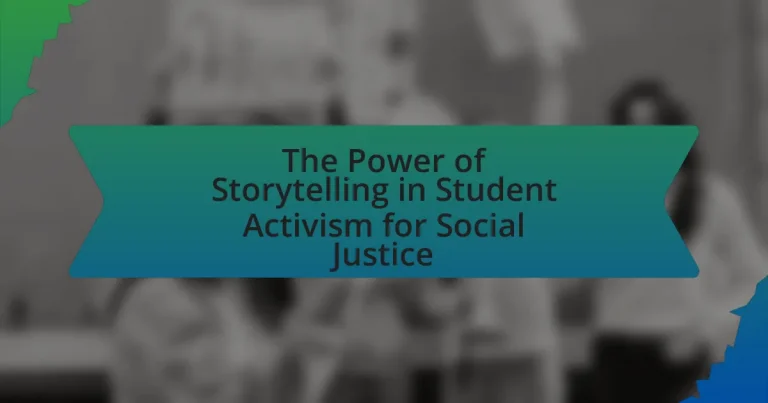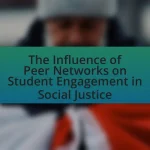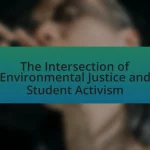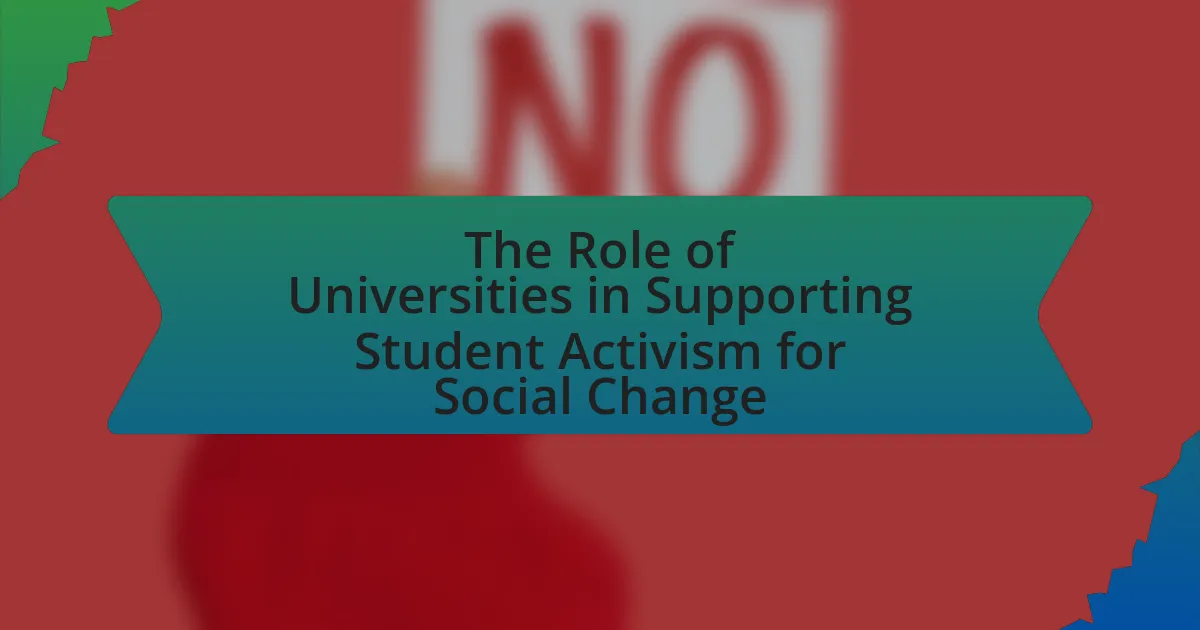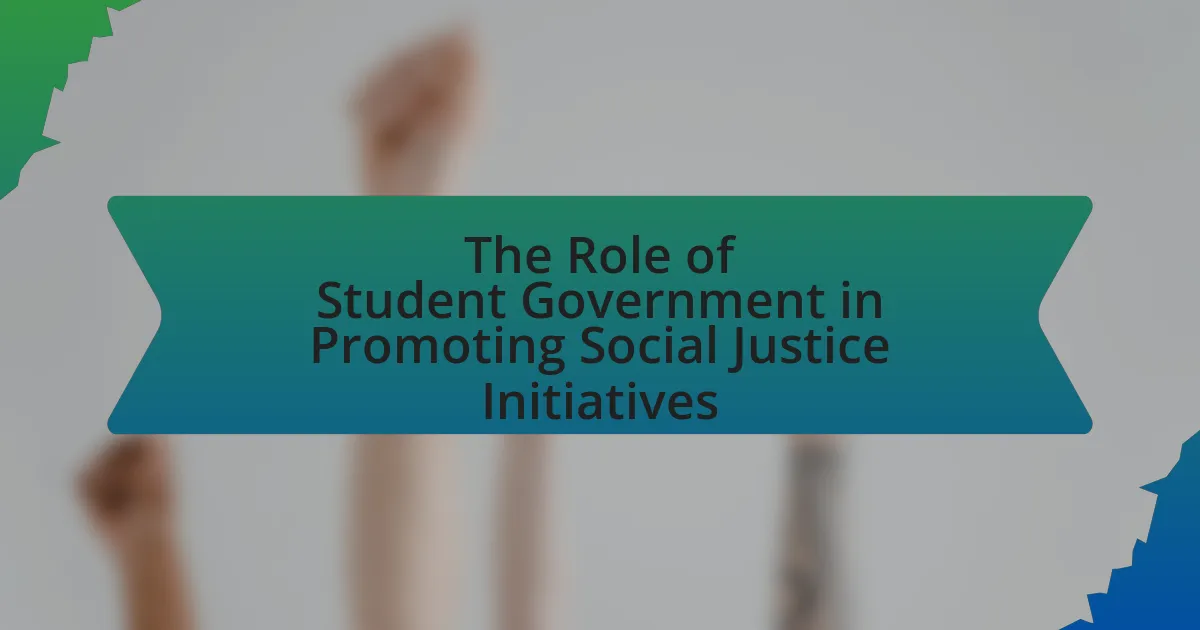The article explores the significant role of storytelling in student activism for social justice, emphasizing its ability to humanize issues and foster empathy. It discusses how personal narratives can enhance student engagement, influence public perception, and mobilize communities by illustrating the impacts of social injustices. Key elements of effective storytelling, including authenticity and emotional connection, are outlined, along with various forms of storytelling such as digital and visual methods. The article also addresses the psychological effects of storytelling, the challenges students face in sharing their narratives, and best practices for harnessing storytelling as a powerful tool for advocacy.
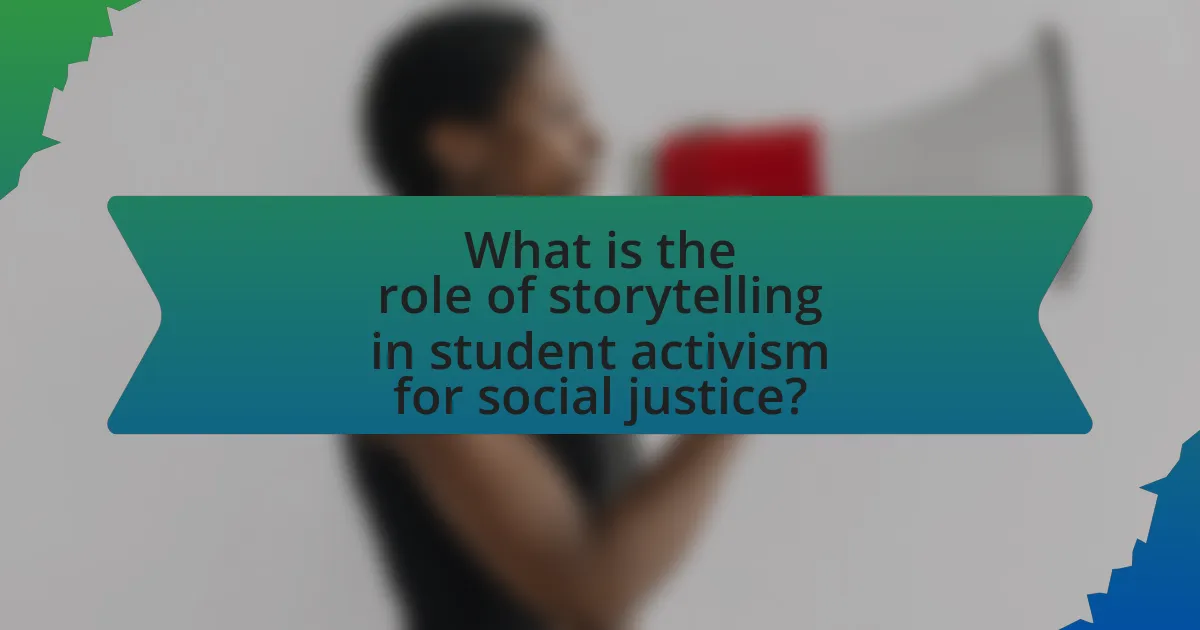
What is the role of storytelling in student activism for social justice?
Storytelling plays a crucial role in student activism for social justice by humanizing issues and fostering empathy among audiences. Through personal narratives, students can illustrate the impact of social injustices, making abstract concepts more relatable and urgent. For instance, movements like Black Lives Matter have utilized storytelling to share individual experiences of racial discrimination, which has galvanized support and raised awareness. Research indicates that narratives can significantly influence public perception and mobilize communities, as evidenced by the success of campaigns that leverage personal stories to highlight systemic inequalities.
How does storytelling influence student engagement in social justice movements?
Storytelling significantly enhances student engagement in social justice movements by creating emotional connections and fostering empathy. When students hear personal narratives related to social justice issues, they are more likely to relate to the experiences shared, which can motivate them to take action. Research indicates that narratives can evoke emotional responses that lead to increased awareness and a sense of urgency regarding social issues. For instance, a study published in the Journal of Social Issues found that storytelling can effectively change attitudes and inspire collective action among young people, demonstrating its power in mobilizing student activism.
What are the key elements of effective storytelling in activism?
The key elements of effective storytelling in activism include authenticity, emotional connection, relatability, and a clear call to action. Authenticity ensures that the narrative reflects genuine experiences and truths, which builds trust with the audience. Emotional connection engages listeners on a personal level, making them more likely to empathize with the cause. Relatability allows the audience to see themselves in the story, fostering a sense of shared experience and urgency. A clear call to action provides direction, motivating the audience to participate or support the cause actively. These elements are supported by research indicating that narratives that resonate emotionally can significantly increase engagement and mobilization in social movements.
How can personal narratives enhance the impact of student activism?
Personal narratives enhance the impact of student activism by fostering emotional connections and increasing relatability among audiences. When students share their personal experiences related to social justice issues, they humanize abstract concepts, making them more accessible and compelling. Research indicates that storytelling can evoke empathy, which is crucial for mobilizing support; for instance, a study published in the journal “Psychological Science” found that narratives can significantly influence attitudes and behaviors by creating emotional engagement. This emotional resonance can lead to greater awareness, increased participation in activism, and a stronger collective identity among students advocating for change.
Why is storytelling considered a powerful tool in social justice advocacy?
Storytelling is considered a powerful tool in social justice advocacy because it humanizes issues and fosters empathy among audiences. By sharing personal narratives, advocates can illustrate the real-life impacts of social injustices, making abstract concepts more relatable and urgent. Research indicates that stories can activate emotional responses, which are crucial for motivating individuals to engage in social change. For instance, a study published in the journal “Social Psychological and Personality Science” found that narratives significantly increased participants’ willingness to support social justice initiatives. This demonstrates that storytelling not only conveys information but also inspires action by connecting people on an emotional level.
What psychological effects does storytelling have on audiences?
Storytelling has significant psychological effects on audiences, primarily by fostering empathy and enhancing emotional engagement. Research indicates that narratives can activate the brain’s mirror neurons, which are responsible for empathy, allowing audiences to connect with characters and their experiences on a deeper level. For instance, a study published in the journal “Science” by Paul Zak found that stories can increase oxytocin levels, a hormone associated with empathy and bonding, leading to a greater emotional response from the audience. Additionally, storytelling can influence attitudes and behaviors by creating a sense of shared identity and purpose, particularly in contexts like student activism for social justice, where personal stories can highlight injustices and motivate collective action.
How does storytelling foster empathy and understanding in social justice issues?
Storytelling fosters empathy and understanding in social justice issues by humanizing experiences and providing personal narratives that resonate emotionally with audiences. When individuals share their stories, they create connections that allow listeners to see the world from different perspectives, which is crucial in addressing complex social issues. Research indicates that narratives can activate empathy by engaging the brain’s emotional centers, making the experiences of marginalized groups more relatable and impactful. For instance, a study published in the journal “Psychological Science” found that participants who read narratives about social injustices showed increased empathy and a greater willingness to support social change initiatives. This demonstrates that storytelling is a powerful tool in promoting awareness and driving action in social justice movements.
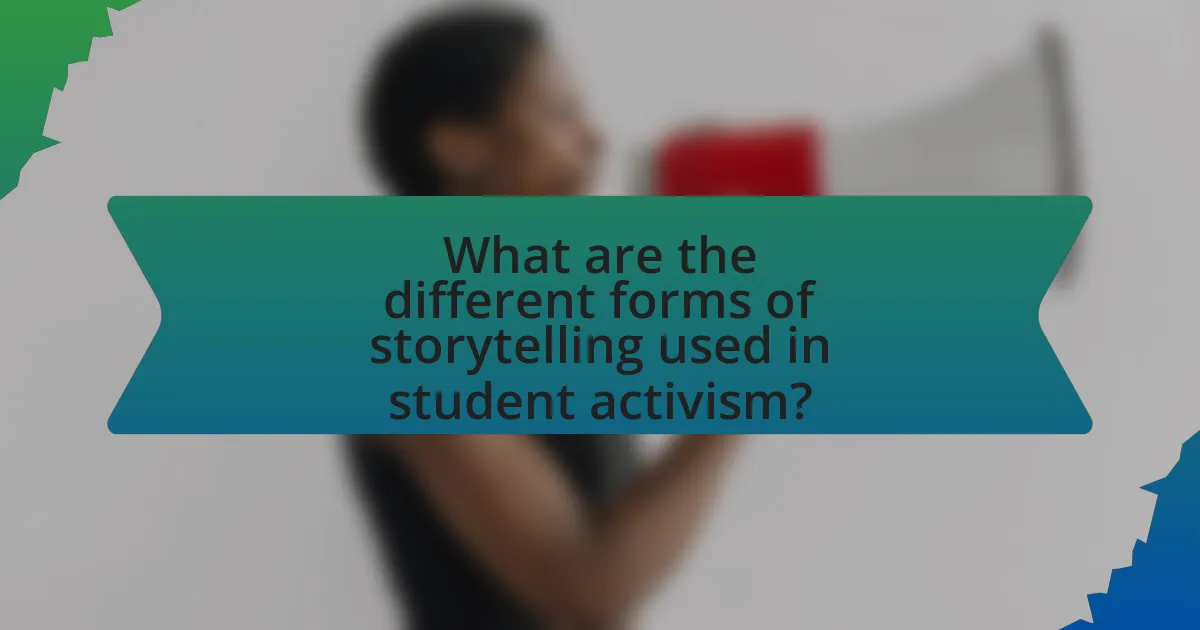
What are the different forms of storytelling used in student activism?
Different forms of storytelling used in student activism include personal narratives, digital storytelling, visual storytelling, and collective storytelling. Personal narratives allow students to share their individual experiences related to social justice issues, fostering empathy and connection among peers. Digital storytelling utilizes multimedia platforms to combine audio, video, and text, making the message more engaging and accessible. Visual storytelling employs images, infographics, and art to convey powerful messages quickly and effectively, often resonating with a broader audience. Collective storytelling involves groups sharing their experiences and perspectives, creating a unified voice that amplifies their message and strengthens community ties. These storytelling forms are essential in mobilizing support and raising awareness for social justice causes within student activism.
How do digital platforms enhance storytelling in activism?
Digital platforms enhance storytelling in activism by providing accessible and widespread channels for sharing narratives, which amplifies voices and mobilizes support. These platforms enable activists to reach diverse audiences quickly, facilitating the dissemination of personal stories and experiences that resonate emotionally. For instance, social media campaigns like #BlackLivesMatter have effectively utilized platforms to share impactful stories, raising awareness and fostering community engagement. Research indicates that storytelling through digital media can increase empathy and understanding, as evidenced by studies showing that narratives shared online can lead to greater public support for social justice initiatives.
What role do social media campaigns play in amplifying student voices?
Social media campaigns play a crucial role in amplifying student voices by providing a platform for expression and engagement. These campaigns enable students to share their stories, mobilize support, and raise awareness about social justice issues, effectively reaching a wider audience. For instance, the #BlackLivesMatter movement, which gained momentum through social media, showcased how students could influence public discourse and policy changes by sharing personal narratives and organizing collective action. Research indicates that social media can increase visibility and foster community among students, enhancing their ability to advocate for change.
How can video storytelling be utilized to convey social justice messages?
Video storytelling can effectively convey social justice messages by creating emotional connections and raising awareness about critical issues. This medium allows for the presentation of personal narratives that humanize abstract concepts, making them relatable and impactful. For instance, studies show that visual storytelling can increase empathy and understanding among viewers, as evidenced by campaigns like “It Gets Better,” which utilized personal videos to address youth suicide and foster acceptance. By combining visuals, sound, and narrative, video storytelling engages audiences in a way that traditional media often cannot, thus amplifying the voices of marginalized communities and driving social change.
What traditional storytelling methods are still relevant in activism today?
Traditional storytelling methods that remain relevant in activism today include oral narratives, parables, and community-based storytelling. Oral narratives allow activists to share personal experiences and cultural histories, fostering empathy and connection among audiences. Parables convey moral lessons and inspire action by illustrating the consequences of social issues. Community-based storytelling engages local voices, empowering marginalized groups to share their stories and advocate for change. These methods have been effective in movements such as the Civil Rights Movement, where personal testimonies highlighted injustices and mobilized support.
How can spoken word and poetry be effective in conveying activist messages?
Spoken word and poetry are effective in conveying activist messages because they utilize emotional resonance and rhythmic language to engage audiences deeply. This form of expression allows activists to articulate complex social issues in a relatable manner, making the messages more accessible and impactful. For instance, the use of personal narratives in spoken word can humanize abstract concepts, fostering empathy and understanding among listeners. Research indicates that performances can evoke strong emotional responses, which are crucial for motivating action and inspiring change. A study by the University of California found that audiences exposed to spoken word performances on social justice themes reported increased awareness and willingness to engage in activism.
What is the significance of community storytelling events in activism?
Community storytelling events are significant in activism because they create a platform for marginalized voices to share personal experiences, fostering empathy and understanding among participants. These events facilitate the exchange of narratives that highlight social injustices, thereby mobilizing community members to engage in collective action. Research indicates that storytelling can enhance emotional connections and motivate individuals to participate in social movements, as evidenced by studies showing that narratives can increase awareness and inspire advocacy efforts. For instance, a study published in the Journal of Community Psychology found that storytelling in community settings significantly improved participants’ commitment to social justice initiatives.
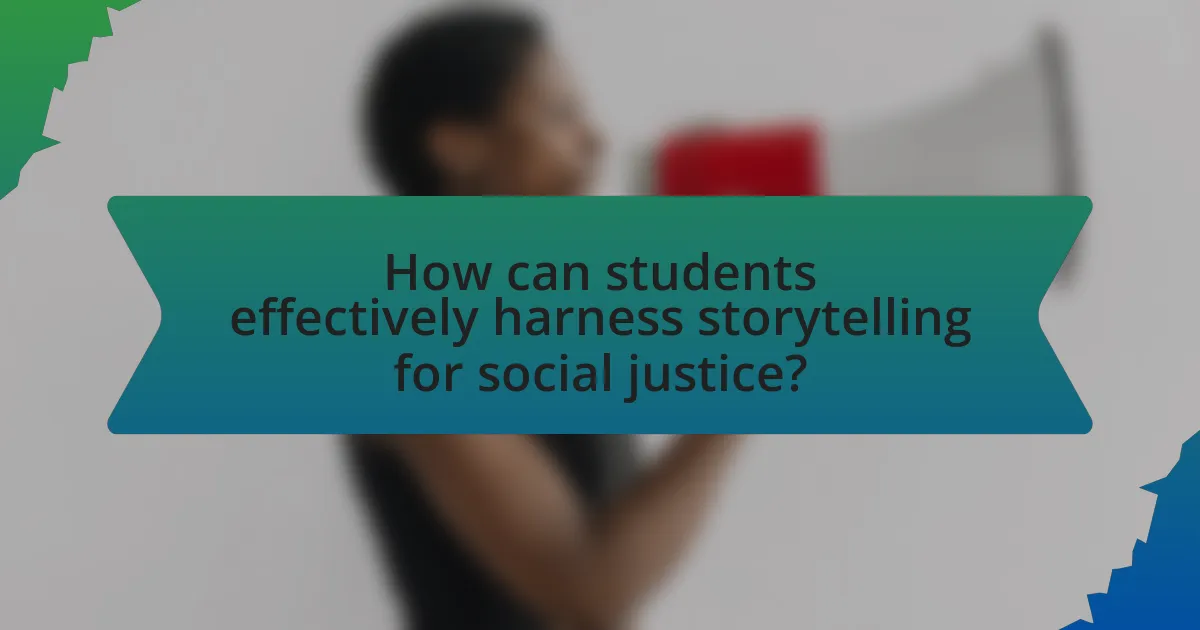
How can students effectively harness storytelling for social justice?
Students can effectively harness storytelling for social justice by using personal narratives to highlight injustices and foster empathy. By sharing their own experiences or those of marginalized communities, students can create emotional connections that inspire action and awareness. Research indicates that storytelling can significantly impact attitudes and behaviors; for instance, a study published in the journal “Psychological Science” found that narratives can change perceptions and motivate individuals to engage in social causes. Additionally, platforms like social media amplify these stories, reaching wider audiences and mobilizing support for social justice initiatives.
What strategies can students use to craft compelling narratives?
Students can craft compelling narratives by employing strategies such as establishing a clear theme, using vivid imagery, and incorporating personal experiences. Establishing a clear theme helps to focus the narrative and convey a specific message, which is essential in activism. Using vivid imagery engages the audience’s senses, making the story more relatable and impactful. Incorporating personal experiences adds authenticity and emotional resonance, which can strengthen the connection with the audience. Research indicates that narratives that evoke emotions are more likely to inspire action, as demonstrated in studies on storytelling in social movements.
How can students identify and articulate their personal stories for activism?
Students can identify and articulate their personal stories for activism by reflecting on their experiences, values, and the social issues that resonate with them. This process involves introspection to uncover significant life events that shaped their perspectives, such as experiences of injustice or moments of empowerment. By connecting these personal narratives to broader social justice themes, students can effectively communicate their motivations and the urgency of their activism. Research indicates that storytelling enhances emotional engagement, making messages more relatable and impactful, as seen in studies highlighting the effectiveness of personal narratives in advocacy campaigns.
What techniques can enhance the emotional resonance of their stories?
Techniques that can enhance the emotional resonance of stories include the use of vivid imagery, relatable characters, and authentic dialogue. Vivid imagery allows readers to visualize scenes and emotions, making the narrative more immersive. Relatable characters foster a connection between the audience and the story, as they see parts of themselves reflected in the characters’ experiences. Authentic dialogue adds realism, allowing the audience to engage more deeply with the characters’ emotions and motivations. Research indicates that narratives employing these techniques can significantly increase empathy and emotional engagement, as demonstrated in studies on storytelling’s impact on social change (Green & Brock, 2000).
What challenges do students face in using storytelling for activism?
Students face several challenges in using storytelling for activism, including a lack of resources, difficulty in articulating their messages, and potential backlash from opposing viewpoints. Limited access to platforms and tools can hinder their ability to effectively share their narratives. Additionally, students may struggle to convey complex social justice issues in a relatable manner, which can dilute the impact of their stories. Furthermore, they often encounter resistance or criticism from those who disagree with their perspectives, which can discourage them from sharing their experiences. These challenges can impede the effectiveness of storytelling as a tool for activism among students.
How can students overcome barriers to sharing their stories?
Students can overcome barriers to sharing their stories by creating supportive environments that encourage open dialogue and active listening. Establishing peer support groups and mentorship programs fosters a sense of community, which can alleviate fears of judgment and promote confidence in sharing personal experiences. Research indicates that storytelling can enhance empathy and understanding among peers, making it easier for students to express themselves. For instance, a study published in the Journal of Social Issues highlights that storytelling in group settings significantly reduces feelings of isolation and increases engagement in social justice initiatives.
What ethical considerations should students keep in mind when telling stories?
Students should prioritize accuracy, consent, and respect for privacy when telling stories. Accuracy ensures that the narratives reflect the truth and do not misrepresent individuals or events, which is crucial in maintaining credibility and trust. Consent involves obtaining permission from individuals whose stories are being shared, particularly when sensitive topics are involved, to honor their autonomy and rights. Respect for privacy means being mindful of the potential impact on individuals and communities, avoiding the disclosure of personal information that could lead to harm or stigmatization. These ethical considerations are essential in fostering responsible storytelling that supports social justice and empowers marginalized voices.
What are some best practices for storytelling in student activism?
Best practices for storytelling in student activism include using personal narratives to create emotional connections, ensuring clarity and authenticity in the message, and leveraging multimedia platforms for broader reach. Personal narratives resonate with audiences, as evidenced by studies showing that stories can increase empathy and engagement, making the cause more relatable. Clarity and authenticity help maintain credibility; research indicates that transparent communication fosters trust among supporters. Additionally, utilizing multimedia platforms, such as social media and video storytelling, enhances visibility and engagement, with statistics showing that visual content is 40 times more likely to be shared than text alone.
How can collaboration with peers enhance storytelling efforts?
Collaboration with peers enhances storytelling efforts by integrating diverse perspectives and experiences, which enriches the narrative. When students work together, they can share unique insights and cultural backgrounds that contribute to a more comprehensive and relatable story. Research indicates that collaborative storytelling fosters creativity and critical thinking, as evidenced by a study published in the Journal of Educational Psychology, which found that group projects led to higher engagement and improved storytelling skills among participants. This collective approach not only strengthens the narrative but also empowers students to advocate for social justice more effectively, as they can draw on a wider array of voices and experiences to resonate with their audience.
What resources are available for students to improve their storytelling skills?
Students can improve their storytelling skills through various resources such as workshops, online courses, books, and storytelling communities. Workshops, often offered by educational institutions or local organizations, provide hands-on experience and feedback from experienced storytellers. Online platforms like Coursera and Udemy offer courses specifically focused on storytelling techniques and narrative structure. Books such as “The Storytelling Animal” by Jonathan Gottschall and “Made to Stick” by Chip Heath and Dan Heath provide valuable insights into the art of storytelling. Additionally, joining storytelling communities or clubs, such as The Moth or local storytelling groups, allows students to practice their skills in a supportive environment. These resources collectively enhance students’ abilities to craft compelling narratives, essential for effective activism in social justice.
